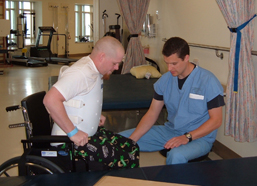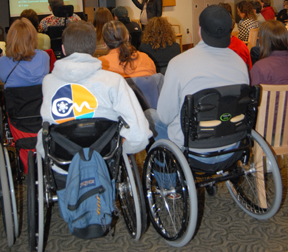Two UW Investigators Report on Secondary Complications after SCI
Using data from the National SCI Statistical Center, researchers in the UW Department of Rehabilitation Medicine recently analyzed data relating to common complications of chronic SCI.
I. Rates and Causes of Rehospitalization after SCI
Diana D. Cardenas, MD, MHA, director of the Northwest Regional Spinal Cord Injury System, and colleagues examined data for 8,668 individuals entered in the national database between 1995 and 2002 to determine the frequency and cause of rehospitalization among persons with chronic SCI, and the factors that might contribute to the development of problems requiring hospitalization.
The researchers found that 28% to 37% of the study group was rehospitalized during the most recent follow-up year, with an average length of hospital stay of 14 days. The three most common reasons for rehospitalization were urinary tract infections and other genitourinary diseases; diseases of the skin, including pressure sores; and diseases of the respiratory system, such as pneumonia. Patients with tetraplegia were hospitalized for respiratory problems more often than patients with paraplegia, and pressure sores were a more common reason for rehospitalization in patients with complete paraplegia.
The researchers found that patients had a greater likelihood of developing a problem requiring hospitalization in later years if they had a lower functional level (measured by the Functional Independence Measure, or FIM) and had been discharged to a skilled nursing facility rather than a private residence after acute rehabilitation. Patients with state or federal health coverage (such as Medicare or Medicaid) were also more likely to need rehospitalization than those with private insurance coverage, perhaps because these government programs limit length of hospital stay in acute rehabilitation.
While rehospitalization rates have been decreasing over the years, they still remain high despite improvements in SCI medical management. A better understanding of issues related to rehospitalization can assist in the prevention and management of secondary complications, decrease the enormous costs of medical care, and improve quality of life in individuals with SCI.
(Study results will be published in the Archives of Physical Medicine and Rehabilitation Medicine.)
II. Major Depression after SCI
In a survey of data from 849 patients from the national database, Charles H. Bombardier, PhD, co-director of the NWRSCIS, and others found that 22% showed signs of major depressive disorder (MDD) one year after injury. Of those, 35.9% said that depressive symptoms interfered very much or extremely with daily activities, and 47.5% reported thoughts of death or suicide. MDD was related to age and marital status, but not injury level or severity.
Symptoms of MDD include depressed mood, loss of pleasure or interest in usual activities, changes in sleep and eating patterns, difficulty concentrating, and self-criticism or hopelessness. Different studies have reported rates of MDD in the general population ranging from 1.8 to 3.3% (past month prevalence) to 4.9 to 17.1% (lifetime prevalence).
The findings from this survey suggest that patients with SCI should be screened routinely for MDD so that appropriate and timely treatment can be offered.






